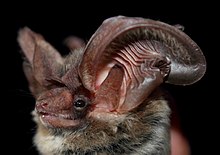| Allen's big-eared bat | |
|---|---|

| |
| Conservation status | |
 Least Concern (IUCN 3.1) | |
| Scientific classification | |
| Domain: | Eukaryota |
| Kingdom: | Animalia |
| Phylum: | Chordata |
| Class: | Mammalia |
| Order: | Chiroptera |
| Family: | Vespertilionidae |
| Tribe: | Plecotini |
| Genus: | Idionycteris Anthony, 1923 |
| Species: | I. phyllotis |
| Binomial name | |
| Idionycteris phyllotis G.M. Allen, 1916 | |

| |
Allen's big-eared bat (Idionycteris phyllotis), also known as the lappet-browed bat, is a species of vesper bat in the monotypic genus Idionycteris. It occurs in Mexico and in Arizona, California, Nevada, New Mexico, Utah, and Colorado in the United States.
Description
Idionycteris phyllotis is a bat with large ears, weighing 8 to 16 grams. On the dorsal side they possess long and soft pelage, (fur). Their fur is basally blackish in color with tips that are a yellow-gray color. They have a black patch on each shoulder, a tuft of white hair on the backside of the ears, as well as ventral hairs that are black with pale tips. The calcar possesses a low keel. The uropatagium has 12 to 13 transverse ribs. The rostrum is flattened and broad. They have distinctive lappets (disc-shaped protrusions), which project from the base of the ears onto the brow of the bat.
I. phyllotis has an external morphology common to that of gleaning bats, and are thus well adapted for plucking stationary insects from surfaces. To do this they have long tragi and ears, wings adapted for maneuverability and hovering flight, and a gracile jaw. I. phyllotis) is the only species in North America known to emit long, constant frequency-frequency modulated echolocation calls.
Range and habitat
Allen’s big-eared bat inhabits the southwestern mountainous regions of Mexico and the United States. This species occupies a wide range in elevation, ranging from 855 m to 3,225 m, though most specimens reside at altitudes between 1,100 m and 2,500 m.
References
- ^ Arroyo-Cabrales, J.; Álvarez-Castañeda, S.T. (2017). "Idionycteris phyllotis". IUCN Red List of Threatened Species. 2017: e.T10790A21990019. doi:10.2305/IUCN.UK.2017-2.RLTS.T10790A21990019.en. Retrieved 12 November 2021.
- ^ Hayes, Mark A.; Navo, Kirk W.; Bonewell, Lea R.; Mosch, Cyndi J.; Adams, Rick A. (2009). "Allen's big-eared bat (Idionycteris phyllotis) documented in Colorado based on recordings of its distinctive echolocation call". The Southwestern Naturalist. 54 (4): 499–501. doi:10.1894/JKF-01.1.
- ^ Czaplewski, Nicholas J. (1983-12-15). "Idionycteris phyllotis". Mammalian Species (208): 1–4. doi:10.2307/3503999. ISSN 0076-3519. JSTOR 3503999.
- "Allen's Big-eared Bat". Bat Conservation International. Retrieved 31 May 2024.
| Taxon identifiers | |
|---|---|
| Idionycteris phyllotis | |
- IUCN Red List least concern species
- Vesper bats
- Bats of Mexico
- Bats of the United States
- Fauna of the Southwestern United States
- Fauna of the Sonoran Desert
- Natural history of Arizona
- Natural history of Nevada
- Natural history of New Mexico
- Endemic fauna of Utah
- Mammals described in 1916
- Taxa named by Glover Morrill Allen